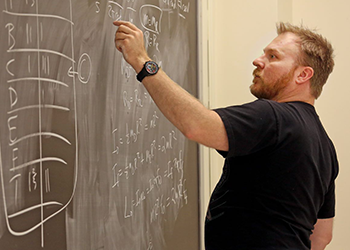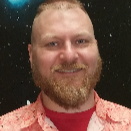Associate Professor and Assistant Department Chair
Physics
I am actively engaged, as a co-investigator, in an international collaboration that has been monitoring radio and X-ray emission from extragalactic supernovae (SNe) for over 20 years. I have the primary responsibility for planning and executing VLA radio observations and conducting the corresponding data analysis. Supernovae are among the most energetic phenomena in the Universe, releasing >1051 ergs in a few seconds with shock speeds >10,000 km s-1. SNe are linked to many of the phenomena of importance to modern astrophysics, e.g. formation of black holes and neutron stars, at least some types of gamma-ray bursters, star-burst galaxies, element formation, the chemical evolution of the host galaxy, cosmological probes, cosmic ray production, creation of interstellar dust, and distribution of heavy elements and energy in the interstellar medium (ISM). While the optical observations study the chemical properties of the progenitor star, they only sample the SN photosphere and ejecta at very early times. Only radio measurements can determine the long-term circumstellar material (CSM) density and radial structure, as the radio emission arises from the interaction from the SN blastwave and the progenitor’s CSM.
We are actively searching for new radio SNe with our Target of Opportunity program and monitor previously discovered radio SNe through our Long-Term Monitoring program. We need to establish a larger radio SNe sample so that we can begin to better understand the final fate of high mass stars. About 40 radio SNe have now been detected, and multi-wavelength radio light curves have been determined for about 25 (only 12 with comprehensive coverage). Radio light curves provide unique information about the evolution of the progenitor star, including the pre-explosion mass-loss history that allows us to better understand the evolution of stars from birth to death. A second component to this effort is the long-term radio, optical, and X-ray monitoring of nearby spiral galaxies that have been host to numerous SNe in the last century.
My recent work involves the radio monitoring of SNe with the VLA, following newly discovered sources as they evolve and periodic monitoring intermediate-age (decades-old) SNe. These short-lived, high mass progenitor stars comprise an exceptionally small subset of a galaxy's stellar population, but they play extremely important roles in heavy element enrichment and in the triggering of star formation within their host galaxies. In particular, the X-ray and radio emission from SNe provide an unparalleled opportunity to study the nature of SNe, supernova remnants, and their CSM and surrounding ISM. For example, in the recent VLA/VLBA study of the type IIb SN 2001gd, we showed that the source has a steeper spectral index than other type II radio SNe and, there appears to be a relation between the spectral index of RSNe and the expansion velocity of the SN blastwave. We may be able to use the spectral index to constrain estimates for the expansion velocity of the blast wave, which is typically difficult to measure accurately and is essential in determining the mass-loss rates of the progenitor star prior to explosion. Another interesting source, SN 2001em was optically classified as a type Ic SN (expected to have very little CSM). My radio study of SN 2001em, initiated two years after explosion, indicates a strong blastwave/CSM interaction, implying a significantly denser, more-distant CSM than models predicted.
In the course of the next five years, I will assume the leadership of the now 25-year-old VLA SN project and further develop our nearby spiral galaxy observing project. These studies constitute the most comprehensive program to date that studies radio SNe as they transition from the explosion of the progenitor stars into supernova remnants. I will continue to search for new radio SNe and monitor the known radio SNe. I will expand our studies of nearby spiral galaxies as part of a VLA legacy project, making deep observations of eight more nearby spiral galaxies. Through a pre-tenure one semester sabbatical in 2007/2008 through Marquette University, I will spend considerable time developing this coordinated effort between these two distinct studies. I am continuing to strengthen my research group, having involved six students over the last three years in my research program, with three as authors or coauthors on published or submitted papers. Through this program, I will increase the number of well sampled radio light curves of SNe and make the deepest, high-resolution radio studies of their host galaxies. This will lead to a better understanding of the environment of SN progenitors, their formation, and their evolution prior to explosion. Finally, we will be able to probe the transition from SN to remnant, which will shed light on how heavy nuclei formed in SN explosions are then mixed into the ISM.
Courses Taught
- General Physics
- Astronomy & Astrophysics
- Physics Major Courses



